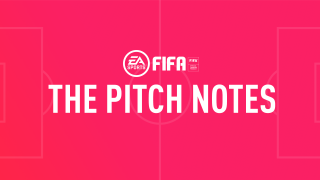
Update on FIFA Connectivity and Responsiveness Efforts
Pitch Notes


Connectivity is always an important topic given the growth and scale of the FIFA community, and you’ve made it clear to us that you want more details about how we’re addressing your concerns and how we’re prioritizing solutions. In the later stages of FIFA 19, we began to share some of the changes that we had implemented to improve the online player experience. And we’re going to give you visibility into some of the additional efforts we’re making around online connectivity, data centers (“servers”), and gameplay responsiveness.
We’re working on optimizing the online FIFA experience daily as there isn’t one single quick fix to this challenge. Not for any game, and especially not for FIFA given its size and scale. This is our challenge and one we’re committed to improving for all of you.
We’re going to be as transparent as we can be. Below are some steps we’re taking, and we’ll provide additional updates to you as we get them.
Why Haven’t You Made This Better Yet?
In short, online connectivity is a complex set of interactions and often depends on the type of game you’re playing, the connection you have, the providers that service your connection and, of course, your location. These issues aren’t something that can be improved with a single patch. The solutions require careful consideration and prioritization.
We know that the internet is generally designed to provide stable connections towards everyday activities like downloading, web browsing, and streaming. Optimizing for precise gaming at this scale is a unique challenge, especially in 1:1 gameplay scenarios that are core to sports and fighting games in which both players need to have all inputs and on-screen actions directly tied to what the other player experiences.
Defining What We’re Talking About & What We’re Working On
Since our last update, our team has been working towards identifying and optimizing for four critical areas. We thought it would be worth defining these here because, for example, what you might call “speed up lag” might mean something entirely different to someone else. Here are the key terms and infrastructure we’ll use here and in future posts:
- Button responsiveness: how quickly the game responds to your inputs.
- Sometimes referred to as “input lag/delay”.
- Input loss: when an input is performed correctly on a controller, but it is not reflected in-game.
- Sometimes referred to as “buttons not registering”.
- Game speed: when the online gameplay does not appear to be running at the expected speed.
- Sometimes referred to as “playing on ice skates”, “game feels slow”, “playing in mud” or “players not getting enough traction”.
- Temporary freezing: when the online gameplay freezes for any amount of time during a match.
- Sometimes referred to as a “micro stutter”.
We have been actively working on these things, and they’re not the only factors we’re testing and trying to improve. And, there are often trade-offs that we have to consider when optimizing the game. For example, the game stutters when packets are getting stuck over the internet. We have intentionally made the game more responsive over the years, which means that if you have a slower internet connection that you could see more stutters. We could artificially 'smooth' this out but that would result in greater delay for other players.
Below are a few additional areas we are working on to enhance the overall experience and as we investigate solutions. Some of these will not bring immediate changes to the gameplay experience but it’s important to understand that there are many factors to consider as we go, and we have ongoing investigations and planned live tests to continue strengthening the experience.
Live Testing
Some connectivity and responsiveness solutions require live testing in order to gain a real-world understanding of their impact. We are in the process of setting up and conducting this testing with limited groups of key players. These tests will provide us with valuable data that will inform future actions taken by our team. The first ones will be looking at button responsiveness and input loss. You can expect to hear more about some of these scenarios early in the new year.
Game Latency Investigations & Improvements
We are continuing to capture data through Gameplay Responsiveness surveys with key members of the community to better assist in latency investigations. Our most recent survey happened last week, and it is the third time we’ve run one like this since launch. The data generated from these surveys allows us to identify key areas of improvement and is helping to drive solutions around the topics noted above.
Data Centers
Since FIFA 20’s launch, we’ve added a new data center and moved 8 additional data centers to optimize our global network, which now consists of 15 locations across 6 continents. We’re currently investigating where it would make sense to add additional data centers in order to improve the matchmaking experience for as many players as possible. As we add more locations, we need to balance a trade-off between a higher likelihood of a good connection for a player and the size of the player pool connecting to each data center to help ensure optimal matchmaking.
Sometimes the data center that’s closest to you isn’t the one that’s going to give you the best experience. This is because some Internet Service Providers (ISPs) don’t always move data directly from point A to point B.
The Matchmaking System
In October, we made a modification to the matchmaking system in FIFA Ultimate Team (FUT). This change was targeted to help increase the quality of online matches by updating rules around acceptable ideal ping thresholds.
We have seen some initial ping improvements across matches globally, and we will continue to monitor the matchmaking system and make adjustments as needed. Our priority with the matchmaking system is to ensure an optimal and fair online experience. We need to then balance and tradeoff between three main factors when tuning our matchmaking: opponent connection quality, skill level gap and the overall time a player must wait to find a suitable opponent; each factor must be carefully weighed to maintain a well-balanced experience. We're also looking at more ways for players to see in-game information about their connection status.
We’d also like to take this opportunity to acknowledge and thank all of you who have been instrumental in sharing feedback and working hand-in-hand with us through this process. We recognize you want more updates, and our aim is to deliver that as we move forward. We will keep the conversation with you going. Keep telling us what you’re experiencing and we’ll keep telling you what we’re doing to help improve your online experience.
You can expect to see these updates in future Pitch Notes and EA Help articles, as well as on @EAFIFADIRECT in the new year, as these concerns remain a top priority for the team.
The FIFA Team
--
For more deep dives on FIFA from members of the game team, check out the Pitch Notes Page.
FIFA 20 is available now for PlayStation 4, Xbox One, and PC.
Stay in the conversation on all things FIFA by liking us on Facebook , following us on Twitter and Instagram, and participating in the official FIFA Forums. Sign-up to receive emails about EA SPORTS FIFA and EA products, news, events, and promotions.

